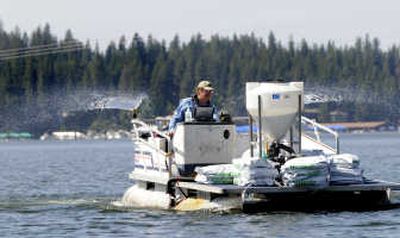Attacking a noxious enemy

HEYBURN STATE PARK, Idaho – The battle for Lake Coeur d’Alene is being waged on its southern shores against an alien invader.
Eurasian milfoil, a nonnative weed introduced to local lakes by unwitting boaters, was discovered along the shorelines of southern Lake Coeur d’Alene and the lower lakes in 2003.
Milfoil forms a mat of thick vegetation that can stop a powerboat in its wake, fatally ensnare a swimmer and wipe out native plant species and wildlife habitat.
Standing between this noxious weed and the more populated north end of the lake is the Coeur d’Alene Tribe, aided by a state Department of Agriculture grant.
“If we can control it here, it will benefit everybody that lives and uses the northern lake,” said David Lamb, the tribal lake ecologist who has led the fight against milfoil for three years.
Since 2006, the Idaho Legislature has appropriated $4 million annually to fight milfoil. The tribe is the third largest recipient of these funds after Bonner and the Inland Empire Cooperative Weed Management area, encompassing Kootenai, Benewah and Shoshone counties.
This year, the tribe received $280,000, which does not cover the entire cost, including labor, of controlling milfoil, Lamb said. It does pay some administrative costs and for the chief weapon in the fight – an aquatic version of 2,4-D, an herbicide commonly used on lawns to control broad-leaf weeds.
This week a small fleet of tribal boats operating out of the Chatcolet boat launch at Heyburn State Park is applying the herbicide to almost 300 acres in southern Lake Coeur d’Alene and in Benewah, Chatcolet and Round lakes. Lamb identified those areas as having been infiltrated with either Eurasian milfoil or a harder to eradicate Eurasian-native hybrid milfoil.
Because of a combination of high water, colder water and silt from unusually high runoff, the weed was harder to spot this year, Lamb said. So he donned diving gear and went looking for milfoil, which is distinguished by its fine, hair-like fronds.
There are other ways to control milfoil: Divers can dredge it, sunken mats can smother it, weevils can eat it. But only herbicides like 2,4-D or triclopyr that don’t affect grasses or native weeds are practical in large areas.
However, divers dredged milfoil at Hawley’s Landing at Heyburn State Park to protect the water potato, which is important to tribal culture.
In other areas, herbicide is being applied by the contractor AquaTechnex LLC in doses considered safe to wildlife and under the scrutiny of a representative of the herbicide manufacturer Applied Biochemists.
Signs posted at docks and landings warned against using treated water for human consumption unless concentrations were tested and shown to be under 70 parts per billion. There were no restrictions in place for swimming or fishing.
The use of herbicide has been met with environmental opposition in such places as Lake Pend Oreille in recent years, but it also has been effective.
Since 1998, milfoil infestation on Hayden Lake has been reduced from 650 acres to 200 acres through herbicide and diver dredging, said Nina Eckberg, weed supervisor for Kootenai County.
The Kootenai Environmental Alliance is skeptical of claims that herbicide use is safe and prefers other methods of aquatic weed control.
“There might be an appropriate place to use herbicides, but it should be a last resort,” said Barry Rosenberg, the alliance’s executive director.
Rosenberg and others believe the encroachment of milfoil and native weeds into North Idaho waterways is the result of “nutrient loading” because of factors such as fertilizer runoff and inadequate septic systems.
Water quality in Lake Coeur d’Alene is “something very near and dear to the hearts” of tribal leaders, said Helo Hancock, tribal legislative affairs director, who accompanied Lamb as the milfoil control project got under way this week.
“Lake management has to become a culture we can all embrace,” Hancock said.
Lamb concurred. Getting people to know that milfoil is a real threat is a good first step, he said. “The next is to get them to quit transporting it.”